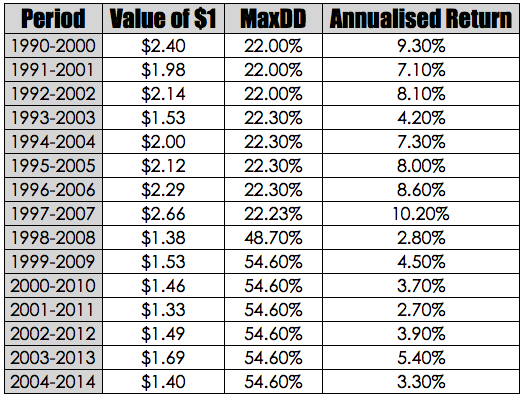One of the more frustrating things about trading is that in some ways your returns are bounded by the environment within which you are investing. This is particularly true if you are dim enough to be a buy and hold investor. The underlying sentiments of markets ebbs and flows and this sentiment infects all aspects of the market. as the old saying goes all ships float on a rising tide, implying that bull markets are good for all stocks and I believe this to be largely true. For aggressive disciplined traders bull markets present a cornucopia of opportunity that is too good to resist. However, flat markets are painful and dull and once again they are especially painful for those who are inactive investors who are merely carried along by what is happening.
I wanted to look at the broad distribution of returns of various periods – this is one of those dodgy back of the envelope things that I like to do. What I did was look at the three metrics as applied to the All Ordinaries, the value of $1 invested for the time period, the maximum drawdown for that period and the annualised return. These are shown below.
I broke the returns up into decades since this is about the average lifespan of an investor/trader. So for the period 1991 to 2001 if you had invested $1 into the All Ordinaries at the beginning of this period by the end it would have been worth $1.98. During that period you would have had to endure a maximum drawdown in your investment of 22% and your annualised return would average out at 7.1%.
There are a few interesting points to this table –
1. The index only produced double digit average annualised growth once in this survey. For the decade sized samples from 1998 onwards the returns were very modest.
2. A single event such as the GFC can have a devastating impact upon long term investment strategies. If you do not take any prudent measures to avoid or manage them. it should be remembered that we are encountering such events about once every ten year.
3. The best decade was 1997 to 2007. However, if I look at these returns in more detail this decade had four good years that produced most of the returns. If I isolate this period of 05/03 to 09/07 I found that $1 invested at the beginning of this period had grown to $2.09 by 09/07 with an annualised rate of return of 18.9%.
4. When you invest matters.
For the sake of completeness I did look at the returns for simply holding throughout this period and the results were as follows –
The above table puts into perspective much of the hype you hear from find managers about being in the market for the long haul, good shares always get better, dont miss the good day blah…blah…blah. Very little that is said by the sell side of the industry stands up to scrutiny – what you see here is very modest returns. I feel that the central point is that the majority of returns are made during very select periods of time and outside of those periods traders either need to be very active or simply search further afield for opportunities.









Excellent analysis – Weathering a 55% drawdown for a 6% annualized return, seems like punishment.
I will prefer lower returns, which limit the drawdowns, as long as I have the potential to participate during a strongly trending phase (2003-7).
Thanks